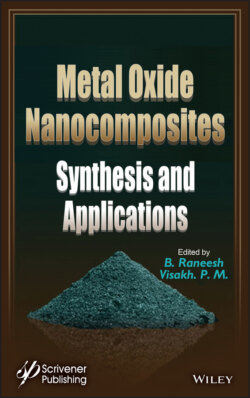Читать книгу Metal Oxide Nanocomposites - Группа авторов - Страница 80
3.4 Graphene-Based Composites
ОглавлениеGraphene is a stimulating substrate for the immobilization of numerous polymeric compounds and nanoparticles of inorganic materials including metal, metal oxide or semiconductor. The decoration of graphene sheets with polymeric and metallic nanoparticles possibly offers a new area of research to investigate the potential in catalytic, magnetic, and optoelectronic applications. Given literature, the metallic nanoparticle decorated graphene sheets offer the ability of their significant use in numerous applications, namely, chemical sensory platforms, hydrogen storage systems, photo-electronic devices, etc. The synthetic routes for the preparation of graphene-inorganic material-based composites are largely categorized into ex-situ and in-situ methodologies as represented in Figure 3.3. In ex-situ synthesis, initially, surface-functionalization of graphene layers is carried out such that they can chelate by non-covalent interactions or covalent linkages, followed by the blending graphene with synthesized nanocrystals of inorganic materials. Such as, the encapsulation of the positively charged SiO2 or Co3O4 nanoparticles onto negatively charged GO through electrostatic interaction, which were further utilized for the Li-ion battery application [27].
Figure 3.3 Types of Graphene-based composites and their synthesis approaches.
While, in in-situ synthesis, the processes encompass nucleation at controlled conditions, thereby, giving upswing to the uniform surface covering of graphene layers. Like as, the chemical reduction process is used to reduce HAuCl4 with NaBH4 in an rGO-octadecylamine (ODA) solution, thus forming graphene-Au composites [28]. Inline to this, hydrothermal treatment is also well investigated in which the functional groups on graphene offer nucleation and anchoring sites for the growth of nanoparticles NPs for the synthesis of Ni(OH)2 nanostructure onto graphene [29]. As well, resembling this, the solvothermal process is also employed for the synthesis of CdS–rGO composites by hydrothermally treating blend of GO and cadmium acetate at 180°C for 12 hours [30]. The results revealed that this in-situ method outcome in high yield formation of single-layer graphene and inhibits their aggregation. Additionally, sol-gel process is engaged for the synthesis of TiO2-GO/rGO composites by the chemical reaction of titanium isopropoxide and GO/rGO sheets which ensued the surface hydroxyl groups on GO/rGO that necessitate nucleation sites [31]. The polymer-graphene composites are formed by the 3D arrangement of polymers onto graphene sheets and on this basis has been classified into three broad categories, namely, graphene-filled, graphene-layered and graphene-functionalized polymer composites. The graphene-filled polymer composites are usually formed by solution mixing, sonication, electropolymerization or melt compounding. Such as, polyaniline has been electro-deposited on graphene paper with an electrolytic solution comprising of aniline monomers by electropolymerization, which outcomes in the random distribution of graphene fillers in the polyaniline polymer matrices [32].
Figure 3.4 Schematic illustration of layer-by-layer deposition of GO sheets onto films of polyelectrolyte PAH (adapted with permission from reference [33]).
Alternatively, the graphene-layered polymer composites are formed by layer-by-layer accumulation with Langmuir–Blodgett (LB) technique. Like as, layer-by-layer deposition of GO sheets onto films of polyelectrolyte poly(allylamine hydrochloride) (PAH) by LB technique, thereby resulting in GO-layered-PAH composites as represented in Figure 3.4 [33]. These GO-layered-PAH composites-based PEMs can be easily suspended over quite a few millimeter apertures and withstand enormous mechanical bends and deformations. As a substitute to filling and layering of graphene onto polymer matrix, an alternative approach of polymer functionalization onto graphene by employing covalent and non-covalent functionalization came to existence. After that, with covalent functionalization of graphene with PVA lead to the formation of GO–PVA composite sheets, centred on the chemical reaction between the surface moieties of the polymers and the oxygenated functionalities on the GO sheets has been demonstrated [34].
